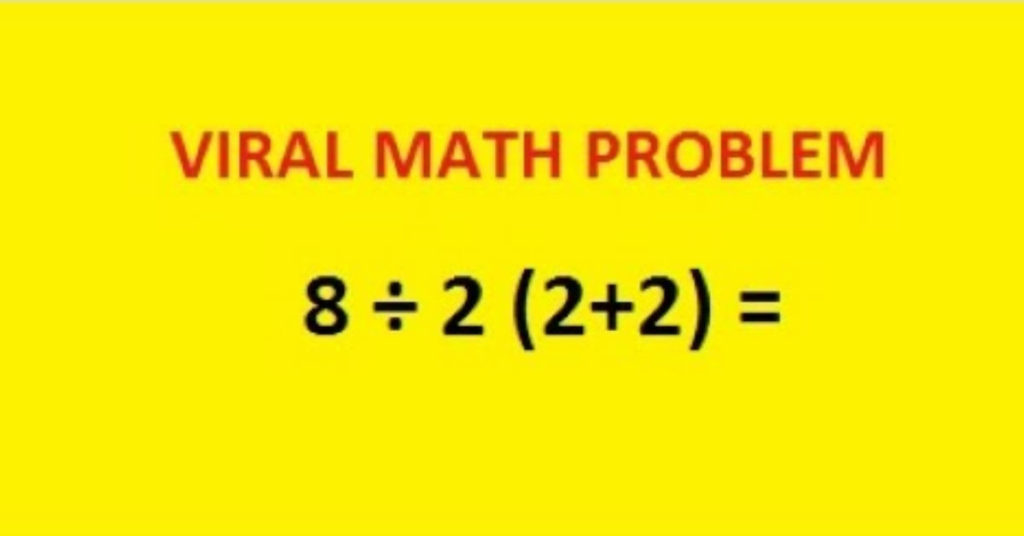You’d think a kid’s math problem would be easy enough for an adult, right? But this particular puzzle is causing major debates all over social media, in office break rooms, and even at family dinner tables. And the wildest part? Half the people say the answer is 1, while the rest are convinced it’s 16.
So, who’s right? Let’s break it down and see if you can solve the math problem that’s making everyone second-guess what they learned in school.

The Problem That Started It All
Here’s the now-viral equation:
8 ÷ 2(2+2) = ?
Looks simple at first glance, doesn’t it? But once people start plugging it into calculators or trying to solve it by memory, all kinds of answers start flying around. Some people are sure it’s 16. Others confidently say it’s 1.
And that’s when things get messy.
Video: 3 by 3 Magic Squad | 3×3 Magic Square | Two Easy methods on 3×3 Magic Square | Magic Square 3*3
Why Two Different Answers Are Being Given
This isn’t about opinions. It’s about the order of operations. You might remember the acronym PEMDAS (or BEDMAS, depending on where you’re from), which stands for:
- P – Parentheses
- E – Exponents
- MD – Multiplication and Division (from left to right)
- AS – Addition and Subtraction (from left to right)
The confusion starts because of how people interpret the expression 2(2+2). Some folks treat it like one chunk due to the parentheses next to a number, and that’s where the misstep happens.
Let’s go step by step.
Step 1: Solve Inside the Parentheses
Start with the obvious: 2 + 2 = 4
Now the problem looks like this:
8 ÷ 2(4)
Still with me? Here’s the twist—this is where most people go off track.
Step 2: Recognize Implicit Multiplication
The term 2(4) is the same as saying 2 × 4. So now the equation becomes:
8 ÷ 2 × 4
Here’s the kicker: you don’t multiply before dividing just because multiplication is written next to parentheses. According to PEMDAS/BODMAS, you perform multiplication and division from left to right—whichever comes first.
So let’s follow that rule:
8 ÷ 2 = 4
4 × 4 = 16
The Correct Answer Is 16.

Still unsure? Punch it into a calculator like this:
8 ÷ 2 × (2 + 2)
If your calculator follows standard order of operations, it’ll return 16 every time.
Why People Are Getting 1 Instead
Now, if someone looks at 8 ÷ 2(2+2) and interprets it as:
8 ÷ [2(2+2)]
Then they’re doing this:
2 + 2 = 4
2 × 4 = 8
8 ÷ 8 = 1
Which looks reasonable—except it ignores the rule that says multiplication and division must be done from left to right, not based on which one “looks” more connected. Parentheses around 2+2 don’t group it with the 2 outside unless there are parentheses explicitly around 2(2+2) as a whole.
When Math Gets Misread
Video: Basic Math Test Quiz – Can You Score 100%?
The lesson here? Not all math is what it seems at first glance. Even simple equations can trip you up if you don’t stick to the proper rules of operation. That’s why math teachers have drilled PEMDAS into students for decades—because the order truly matters.
A misplaced parenthesis or skipped step can completely change your answer.
Real-Life Proof of Confusion
This math problem has gotten so out of hand that some offices have reached out to actual mathematicians to settle the debate. Online forums like Reddit and Twitter are packed with threads, videos, and heated arguments about it.
What’s crazy is that this isn’t a trick question—it’s just a test of how well we’ve retained basic math rules. And clearly, a lot of adults either forgot them or never fully understood them in the first place.
Why Math Puzzles Like This Go Viral
There’s a reason these simple math problems pop up online every few months. They:
- Challenge your brain in unexpected ways
- Spark instant debate—everyone wants to be right
- Highlight generational gaps in education
- Are just plain fun for puzzle lovers
Plus, solving a problem that most people get wrong? Feels awesome.
Bonus: Try These Other Tricky Puzzles
Now that you’ve solved the equation, here are a few other math riddles to test your skills:
- 6 ÷ 2(1+2) = ?
- 50 – 5 × 6 = ?
- (4+2)² ÷ 3 = ?
Don’t forget—follow PEMDAS, go step-by-step, and double-check before declaring your answer out loud!
Conclusion: It’s Not About Being Smart—It’s About Knowing the Rules

The viral math problem 8 ÷ 2(2+2) isn’t hard—it just requires discipline. You’ve got to fight the instinct to group things incorrectly or rush to an answer based on how the numbers “look.”
The next time you stumble across a math riddle like this, take a breath, remember PEMDAS, and work it left to right. Math doesn’t lie—but it definitely demands that we pay attention.
So… did you get 16? Or were you in the “1” club? Either way, now you know the truth—and you can settle the argument once and for all.


